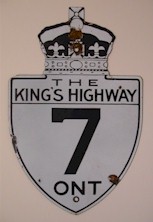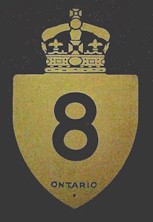Small Size King's Highway Signs (Used from 1930 to 1962):
GROUP ONE - Used from 1930 to 1955
Small Signs with "THE KING'S HIGHWAY" legend:
In 1930, an act was passed which changed the designation of Provincial Highways in Ontario to
"King's Highways". The reigning English monarch at the time was His Majesty King George V. At
that time, all of the old Provincial Highway signage was replaced with signs bearing the new
highway designation. The new King's Highway signs were quickly installed throughout the
province. Over 9,000 of the new signs had been erected on Ontario King's Highways by the end of
1932. The King's Highway sign configuration was far more convoluted than that of its
Provincial Highway predecessor. The new signs were redesigned, and a cut out "shield" style
sign was introduced. To reflect the new regal designation, a crown was added to the top of the
shield. The crown was very intricate, even showing renditions of individual jewels and pearls.
This resulted in a unique, highly irregular, but very recognizable sign shape. The signs
read "THE KING'S HIGHWAY" followed by the route number underneath. At the bottom of the sign,
the vertical interlocking letter format of "ONT" was discontinued. The letters "ONT" appear in
a horizontal line below the route number on this sign type. This is a picture of a "Group 1"
King's Highway 7 sign, showing the sign layout:

The earliest of the "Group 1" King's Highway signs were made of a porcelain enamel surface,
applied to a steel backing. The sign dimensions are 47 cm by 30 cm (19" by 12", at its widest
point) and are black-on-white in colour. The porcelain enamel signs were highly susceptible
to chipping. The signs were damaged easily from stones and other sundry roadside debris flung
at the signs from passing vehicles. However, the biggest problem with the porcelain enamel
signs was that they were not reflective, and thus were hard for motorists to see at night.
The porcelain signs were phased out in the late 1930s and 1940s. Later signs of this type are
made of various reflective material applied to a steel backing, as described in the preceding
paragraphs. These reflective signs were generally produced after 1937, exclusively. The most
recent signs in this group (1950s) have a distinctive "yellowed" look to them. This was due to
a special treatment applied to the signs to make them even more reflective, like this example:

GROUP TWO - Used from 1955 to 1960
Small Signs without "THE KING'S HIGHWAY" legend:
The passing of His Majesty King George VI in 1952 created an unfortunate situation for the
Department of Highways. The presumption of the naming of "The King's Highways" was that the
reigning monarch was generally a King. However, shortly after the coronation of Her Majesty
Queen Elizabeth II, it was decided to remove the legend "THE KING'S HIGHWAY" from all highway
signage, in recognition of the new Sovereign. Signs made between 1955 and 1960 made no
reference to "The King's Highway" designation, despite the fact that the roads were known
officially and legally as King's Highways. Also, the province's name "ONTARIO" was spelled out
on these signs, as opposed to being abbreviated as "ONT". The sign dimensions were still 47 cm
by 30 cm
(19" by 12", at its widest point) and were black-on-white in colour. These signs were made
exclusively of reflective material applied to a steel backing. Porcelain enamel highway signs
were by that time obsolete, and were thus not seen in this sign group. This is a picture of a
"Group 2" King's Highway 8 sign, showing the sign layout (Photo Courtesy Brian Weaver):

GROUP THREE - Used from 1960 to 1962
Small Signs with "THE KING'S HIGHWAY" legend restored:
In 1960, it was decided to reinstate the legend "THE KING'S HIGHWAY" on the signs. The legend
had been omitted for several years during the 1950s, after the coronation of Queen Elizabeth
II. A notable change was made to the signs at that time. The legend appeared in one continuous
line, as opposed to the previous practice, which saw the legend broken onto two lines. As with
the Group 2 Signs, the province's name "ONTARIO" was spelled out, as opposed to being
abbreviated as "ONT". The sign dimensions were still 47 cm by 30 cm (19" by 12", at its widest
point) and were black-on-white in colour. This is a picture of a "Group 3" King's Highway 5
sign, showing the sign layout:

This last group of small size signs was phased out in the early 1960s, as they were difficult
to see when motorists passed the signs at high speeds. In 1962, the small-size signs were
removed altogether from the Department of Highways' sign manual, rendering them obsolete. All
crown-shield signs made since 1962 have been the large size signs, as described below.
| 

